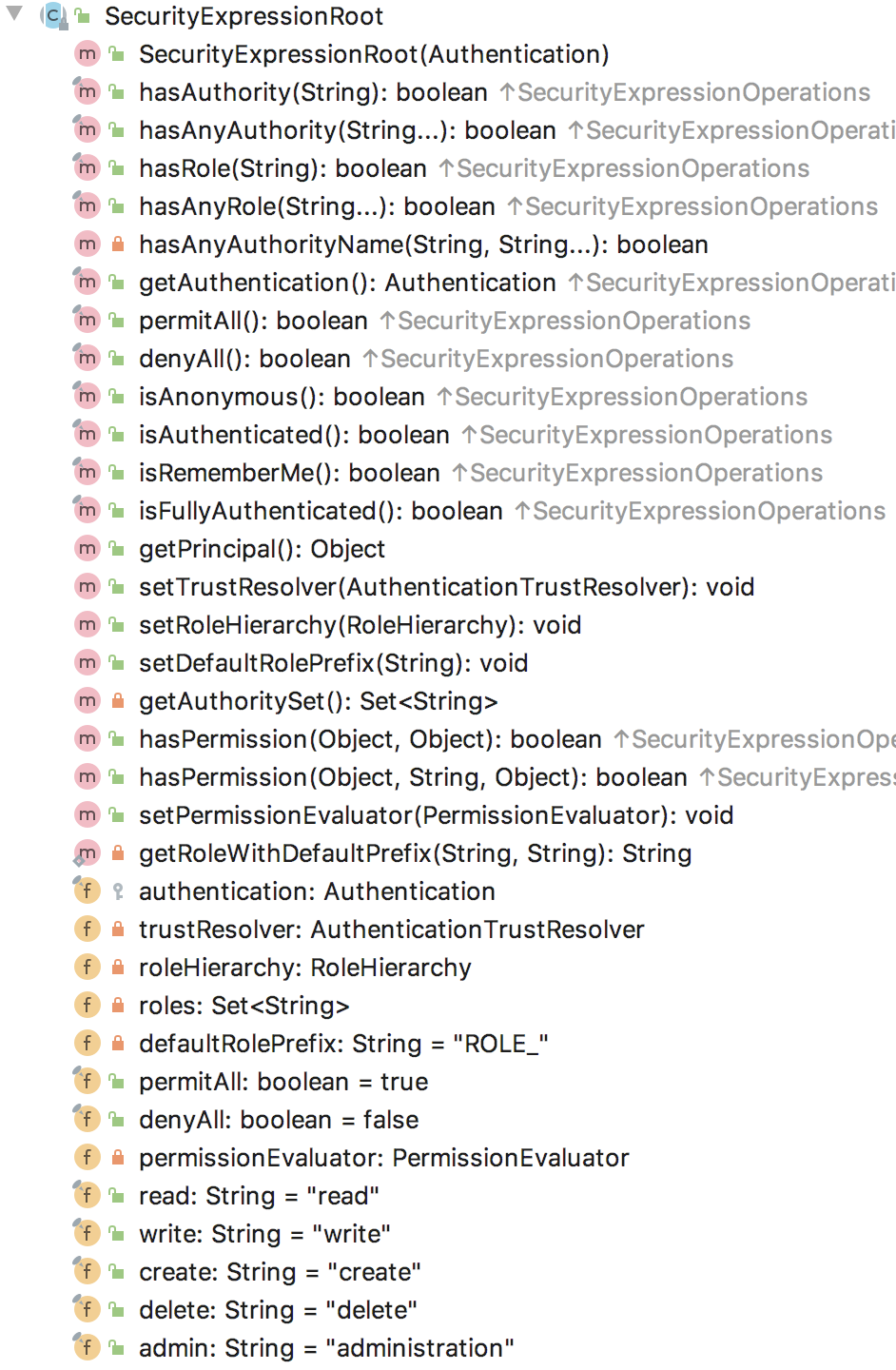在前面的文章 中,松哥已经和小伙伴们聊了 Spring Security 中的权限表达式了,还没看过的小伙伴们可以先看下,本文将在前文的基础上继续完善:
1. SpEL 回顾 经过上篇文章 的学习,小伙伴们已经知道了,在 Spring Security 中,@PreAuthorize、@PostAuthorize 等注解都是支持 SpEL 表达式的。
在 SpEL 表达式中,如果上来就直接写要执行的方法名,那么就说明这个方法是 RootObject 对象中的方法,如果要执行其他对象的方法,那么还需要写上对象的名字,例如如下两个例子:
1 2 3 4 @PreAuthorize("hasAuthority('system:user:add')") public String add () { return "add" ; }
上面这个例子中,表达式中的方法是 hasAuthority,没有写对象名,那么就说明这个方法是 SpEL 中 RootObject 对象中的方法。
1 2 3 4 5 6 7 @PreAuthorize("@ss.hasPermi('monitor:operlog:list')") @GetMapping("/list") public TableDataInfo list (SysOperLog operLog) { startPage(); List<SysOperLog> list = operLogService.selectOperLogList(operLog); return getDataTable(list); }
上面这个例子中,权限注解中的表达式方法是 @ss.hasPermi('monitor:operlog:list'),其中 ss 是指 Spring 容器中的一个对象名,hasPermi 则是这个对象中的方法。
好啦,经过前面文章 的学习,这些基本知识大家都已经掌握了。
2. 如何自定义 其实上面给出来的第二个例子就是一个自定义的例子。
不过,这种自定义方式太自由了,自由到没有在 Spring Security 架构内完成这件事。所以,今天我想和小伙伴们聊一聊,如何在不使用第三方对象的情况下,来自定义一个权限判断的表达式。
首先小伙伴们知道,我们在 @PreAuthorize 注解中使用的不用加对象名就能调用的权限方法,如 hasAuthority、hasPermission、hasRole、hasAnyRole 等,基本上都是由 SecurityExpressionRoot 及其子类提供的,准确来说是由 MethodSecurityExpressionRoot 类提供的。
MethodSecurityExpressionRoot 类实际上继承自 SecurityExpressionRoot,只不过增加了过滤对象以及返回值对象。我们来看下 MethodSecurityExpressionRoot 的方法摘要:
再来看看 SecurityExpressionRoot 中的方法:
这些就是 RootObject 对象中的所有方法了,也是我们能够在 @PreAuthorize 注解中使用的所有方法了。
那么现在想在已有方法上继续扩展新方法,那么我们可以通过自定义类继承自 SecurityExpressionRoot 对象,扩展这个 RootObject 对象,在该对象中继续添加新的方法,进而实现自定义权限表达式。
好啦,说干就干,开搞!
本文的案例在前文 的基础上继续完成,所以这里我就不从头开始写了。
3. 自定义 ExpressionRoot 首先我们自定义一个类继承自 SecurityExpressionRoot 并实现 MethodSecurityExpressionOperations 接口(本来直接继承自 MethodSecurityExpressionRoot 即可,但是因为这个类不是 public 的,没法继承,所以我们就实现 MethodSecurityExpressionOperations 接口即可):
1 2 3 4 5 6 7 8 9 10 11 12 13 14 15 16 17 18 19 20 21 22 23 24 25 26 27 28 29 30 31 32 33 34 35 36 37 38 39 40 41 42 43 44 45 46 47 48 49 50 51 52 53 54 55 56 57 58 59 60 61 62 63 64 65 66 67 68 69 70 71 72 73 74 75 76 77 78 79 80 81 82 83 84 85 86 87 88 89 90 91 92 93 94 95 public class CustomSecurityExpressionRoot extends SecurityExpressionRoot implements MethodSecurityExpressionOperations { private Object filterObject; private Object returnObject; private AntPathMatcher antPathMatcher = new AntPathMatcher (); public CustomSecurityExpressionRoot (Authentication authentication) { super (authentication); } public boolean hasPermission (String permission) { Collection<? extends GrantedAuthority > authorities = authentication.getAuthorities(); for (GrantedAuthority authority : authorities) { if (antPathMatcher.match(authority.getAuthority(), permission)) { return true ; } } return false ; } public boolean hasAnyPermissions (String... permissions) { if (permissions == null || permissions.length == 0 ) { return false ; } Collection<? extends GrantedAuthority > authorities = authentication.getAuthorities(); for (GrantedAuthority authority : authorities) { for (String permission : permissions) { if (antPathMatcher.match(authority.getAuthority(), permission)) { return true ; } } } return false ; } public boolean hasAllPermissions:(String... permissions) { Collection<? extends GrantedAuthority > authorities = authentication.getAuthorities(); if (permissions == null || permissions.length == 0 ) { return false ; } for (String permission : permissions) { boolean flag = false ; for (GrantedAuthority authority : authorities) { if (antPathMatcher.match(authority.getAuthority(), permission)) { flag = true ; } } if (!flag) { return false ; } } return true ; } @Override public void setFilterObject (Object filterObject) { this .filterObject = filterObject; } @Override public Object getFilterObject () { return filterObject; } @Override public void setReturnObject (Object returnObject) { this .returnObject = returnObject; } @Override public Object getReturnObject () { return returnObject; } @Override public Object getThis () { return this ; } }
加了 @Override 注解的方法,都是普普通通的常规方法,没啥好说的。我们自己主要实现了三个方法,分别是:
hasPermission:判断当前用户是否具备某一个给定的权限。
hasAnyPermissions:判断当前用户是否具备给定的多个权限中的某一个。
hasAllPermissions:判断当前用户是否具备所有的给定的权限。
这里边的逻辑我就不啰嗦了,都是基本的 Java 语法而已。
另外,用 AntPathMatcher 做比对是为了支持通配符,这个在上篇文章 中已经说过了,这里不再赘述。
Spring Security 中,MethodSecurityExpressionRoot 的配置是通过 DefaultMethodSecurityExpressionHandler 来完成的,现在我们自定义了 CustomSecurityExpressionRoot,那也得有一个 Handler 来配置 CustomSecurityExpressionRoot,所以,再来一个类继承自 DefaultMethodSecurityExpressionHandler,如下:
1 2 3 4 5 6 7 8 9 10 public class CustomMethodSecurityExpressionHandler extends DefaultMethodSecurityExpressionHandler { @Override protected MethodSecurityExpressionOperations createSecurityExpressionRoot (Authentication authentication, MethodInvocation invocation) { CustomSecurityExpressionRoot root = new CustomSecurityExpressionRoot (authentication); root.setTrustResolver(getTrustResolver()); root.setPermissionEvaluator(getPermissionEvaluator()); root.setRoleHierarchy(getRoleHierarchy()); return root; } }
在 createSecurityExpressionRoot 方法中创建一个 CustomSecurityExpressionRoot 对象,对象的 TrustResolver、权限评估器以及角色层级等,统统都用默认的方案即可。
配置完成后,再配置一下 CustomMethodSecurityExpressionHandler 这个 Bean 即可,如下:
1 2 3 4 @Bean CustomMethodSecurityExpressionHandler customMethodSecurityExpressionHandler () { return new CustomMethodSecurityExpressionHandler (); }
好啦,这就注入成功了。
接下来,我们就可以在权限注解中使用这个自定义的方法了:
1 2 3 4 @PreAuthorize("hasPermission('system:user:add')") public String add () { return "add" ; }
这个自定义权限表达式的思路,说到底还是在 Spring Security 体系中玩,个人感觉这种方式更合理一些。
在 TienChin 项目中,松哥也将按照这种思路去改造 RuoYi-Vue 脚手架。届时在 TienChin 项目视频中,我再和大伙细聊,对视频感兴趣的小伙伴,戳这里:TienChin 项目配套视频来啦 。


